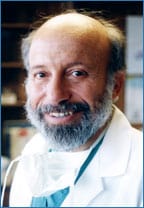Ask The Doctor
By Sherman Silber, MD, St. Luke’s Infertility Specialist
Health & Harmony
Spring/Summer, 2007
 Mini-IVF (In Vitro Fertilization)
Mini-IVF (In Vitro Fertilization)
Q. Explain the new, low cost innovative fertility treatment known as mini-IVF.
A. Mini-IVF is a new approach to IVF, which was developed in Japan as part of the Kato Clinic-St. Luke’s Collaborative Program. “Mini-IVF” avoids many of the common complaints that patients have about conventional IVF. It costs much less, and avoids the complications of hyperstimulation and excess hormones.
Unlike conventional IVF, mini-IVF is designed to retrieve only a few, high quality eggs instead of large numbers of mediocre ones. As a result, the procedure completely eliminates the risk of hyperstimulation

Infertility Center of St. Louis
at St. Luke’s Hospital
syndrome, in which a fluid imbalance causes dehydration due to body fluids that collect in the abdomen. In addition, the cost of the drugs is reduced from $7,000 to about $700. There are very few injections and it does not require painful progesterone injections.
With mini-IVF, the patient starts on a low dose of Clomid, a drug used to stimulate ovulation, on day three of her menstrual cycle and continues taking the Clomid until ultrasound monitoring shows she is ready to ovulate. Continuing on Clomid reduces the chance of premature ovulation while allowing for the development of high quality eggs for IVF.
Although Clomid results in very high quality eggs, it can inhibit development of the uterine lining, making the embryos less likely to implant. This can be solved, however, by employing a remarkable, new method of embryo freezing called vitrification (also developed by the Kato Clinic-St. Luke’s Collaboration). This method is safe because the frozen embryos suffer no damage from this type of freezing, and they have the same success as fresh, unfrozen embryos. The frozen embryos are then transferred into the uterus during a subsequent natural cycle without the need for taking any hormones at all.
Also, whether using minimal stimulation, or conventional stimulation of the ovaries, vitrification [see technical video] of the embryos is so effective that it allows the transfer of only one embryo at a time. This eliminates the risk of dangerous multiple pregnancies such as triplets or quadruplets which carry a greater risk to both mother and child.

 Mini-IVF (In Vitro Fertilization)
Mini-IVF (In Vitro Fertilization)